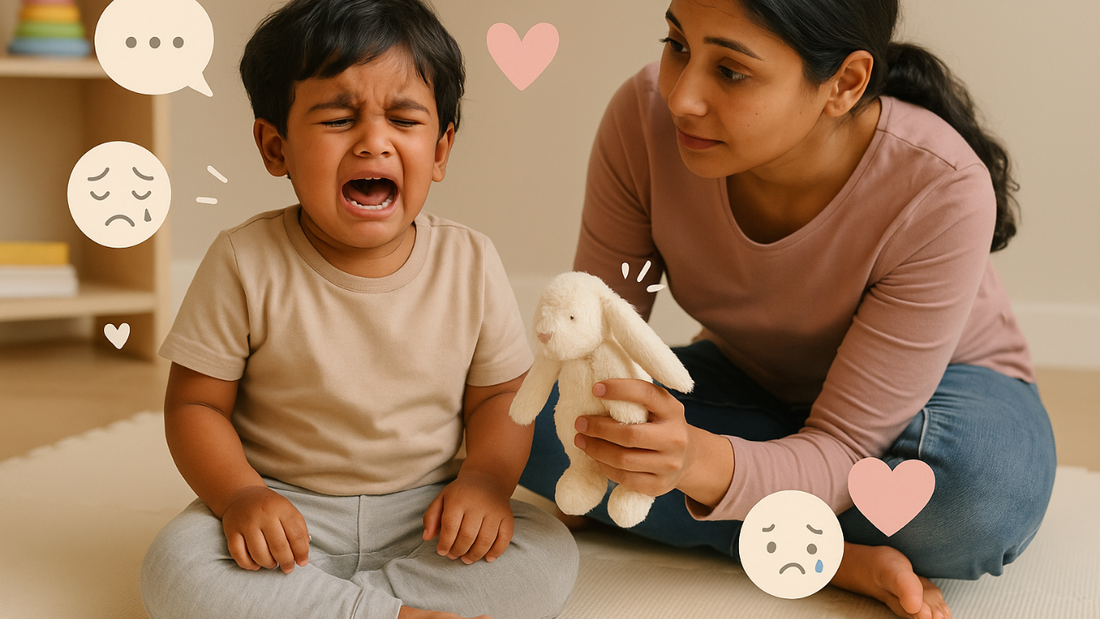
Helping Toddlers Handle Big Emotions with Love and Play
LiLLBUDThe joy of toddler years are a magical mix of first words, wobbly steps, and wide-eyed curiosity but they’re also full of big feelings. From unexpected tears over the wrong color cup to full-blown meltdowns in the grocery store, toddler emotions can be overwhelming… for both the child and the parent.
But here’s the good news: these emotional outbursts are not only normal—they’re a critical part of healthy development.
In this post, we’ll dive into how to understand your child’s emotions, support their growth through play, and use gentle, effective parenting tips to guide your toddler through these early emotional milestones.
Understanding Toddler Emotions (And Why They're So Intense)
Toddlers between 1 and 3 years old are undergoing quick emotional and brain development. They're picking up on:
- What emotions are
- How to express their feelings
- How to control frustration, fear, happiness, and the rest
This is a core stage of emotional development from 0 to 3 years, and it aligns with other key baby milestones by month, including:
- Learning to say “no”
- Showing empathy (like offering a toy when someone is sad)
- Expressing preferences and independence
Toddlers don’t misbehave because they’re “naughty” they just don’t yet have the tools to manage their emotions. That’s where love, connection, and play come in.
The Link Between Emotional and Brain Development
Your toddler’s brain is developing at lightning speed–especially the areas used for impulse control, empathy, and managing emotions.
When you support your child’s feelings with calm and empathy, you create build strong brain connections that:
- Reduce future tantrums
- Boost confidence and self-worth
- Teach lifelong coping skills
Combining emotional validation with age-appropriate brain development toys and Montessori toys can assist toddlers process emotions in a hands-on, safe way.
Play-Based Tools to Support Emotional Growth
Below are some effective ways to utilize play as a tool to facilitate toddler emotions and promote healthy expression of emotions:
1. Emotion Puppets or Flash cards
You can use simple puppets or animal toys to act out the emotions. Act out the following scenarios, for instance, “Rabbit feels sad because he dropped his snack. How can we help?"
This boosts empathy and problem-solving through pretend play.
2. Montessori-Inspired Emotion Cards
Show photos or sketches of real facial expressions. Try asking, “Which one looks happy? or Which one looks sad?”
It is good for building observation skills and emotional vocabulary.
3. Cozy Corners or Calm-Down Spaces
Make a cozy, comforting corner with soft pillows, books, a plush toy, or a favorite Montessori toy. When toddlers become overwhelmed, this area allows them a chance to self-soothe.
Add items like sensory bottles or squishy fidget toys to help them regulate through touch.
4. Movement-Based Play
Toddlers tend to show emotions through their bodies. Below are a few games that you can try with them:
- Animal walks (roaring like a lion = anger release!)
- Jumping on a soft mat
- Dancing out feelings to music
Because physical play enables the release of built-up tension and frustration in a constructive manner.
5. Books That Name Emotions
Toddlers feel understood by stories featuring characters who are feeling mad, sad, scared, or happy. pause and try asking them:
- “Did you ever feel like that?”
- “What do you think is going to happen next?”
Reading together strengthens your relationship while fostering emotional development and bonding in early years.
Parenting Tips: How to Respond to Big Feelings with Love
Your calm presence is the most important tool during emotional storms. This is how you can support your toddler through it:
- Name the feeling: “You’re upset because we had to leave the park.”
- Validate their experience: “It’s okay to feel upset. I’m here with you.”
- Offer comfort or space: Offer a hug, a toy, or just sit quietly near them, depending on your toddler’s cues.
- Use play later to process: After the moment has passed, retell the story with dolls or drawings.
Gentle guidance during these moments not only offers your toddler learn to self-regulate–it also builds trust and resilience.
Emotional Milestones to Watch By Age
Although each child develops at their own pace, but here are some typical emotional milestones to look for:
a). 12–18 Months
- Shows basic emotions like happiness, frustration, fear
- Begins to show anxiety when separated
- Might have early tantrums
b). 18–24 Months
- Tries to comfort others
- Uses a few emotion words (“mad,” “sad”)
- Begins expressing independence
c). 2–3 Years
- Starts using pretend play to express feelings
- Can identify more emotions
- Tantrums may increase as language struggles peak
These milestones align with other key baby milestones by month, and each step is part of a healthy emotional journey.
Play Is Their Language. Love Is the Lesson.
Your toddler is discovering what it means to be a person—with needs, preferences, and feelings. They may not always have the words or skills yet, but they do have you.
Through love, patience, and a few well-chosen Montessori learning toys, you can guide your toddler navigate their emotions and grow into a confident, empathetic human being.
So next time you’re facing a toddler meltdown, remember: it’s not misbehavior. It’s development in action. And your connection is the most powerful tool of all.

